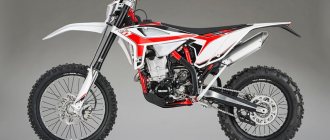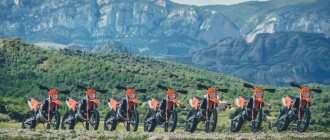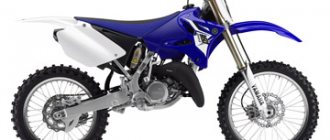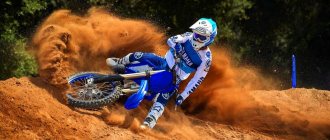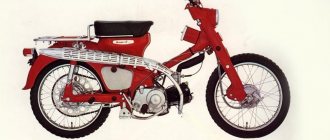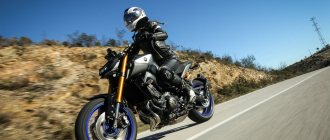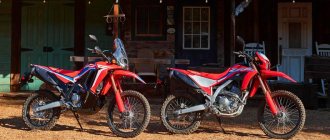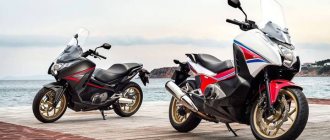Comparative test by six riders of five hard enduro motorcycles Beta 430 RR Race Edition 2021, Honda CRF450X 2021, Suzuki RMX450Z 2020, TM Racing EN 450Fi 2021, Yamaha WR450F 2021.
Yes, yes, without KTM and Husqvarna!
There is an opinion that off-road motorcycles should be extremely light and simple. For example, like motocross motorcycles: no lighting, side stands, frills such as odometers or large tanks. But in reality this is not so: there are models that can do a lot, and at the same time are more comfortable (in a broad sense) than cross-country shoes. Today we'll talk about enduro.
We took five motorcycles, suitable for both racing on the track and for traveling in search of adventure. The test consisted of two days: on the first we visited the cross-country site (which, to our great joy, was somewhat damaged by rain, so it was in decent condition). There was no special toughness here, just a fairly narrow route consisting of straight sections connected by turns. On the second day, for the purity of the experiment, we went in a direction where no one had ever been, and along the road we encountered a sandy area, a rocky plateau, a narrow path, jumps, and to top it all off, a considerable hill.
Enduro test 2021. Beta RR, Honda CRF, Suzuki RMX, TM EN, Yamaha WR
Cross and enduro are similar in many ways, but in enduro there are no elements, but rather directions. In the sense that an enduro motorcycle encounters such different conditions that it is difficult to find a model that would cope with everything equally well. And a motorcycle that behaves perfectly when you’re driving along sand dunes in fifth gear is very different from a motorcycle that perfectly drives up a slippery and smooth waterfall. Nevertheless, we tried very hard to find as many landscape options as possible in order to seriously test the experimental subjects.
By the way, about landscapes. Part of the enduro route, unlike cross-country, may well run on asphalt.
In order not to ramble on for too long, I’ll tell you how the seats were distributed. Each of the six testers ranked the bikes from fifth to first. By adding up the ratings of each motorcycle, we found out what each of them costs. And then we present the opinion of each tester for each model.
About testers. They vary in weight, height and age, but four of the six are professional enduro riders (who have completed their professional careers), another considers himself an intermediate amateur, and the last is an advanced amateur.
Recommendations for choosing an enduro motorcycle
Characteristic features of enduro.
To choose a durable and patient motorcycle (translated from the Latin indurare), you should highlight its distinctive features.
- The bike has a small weight category (100-150 kg). Most often, novice motorcyclists choose the lightest models (100-110 kg).
- Enduros are equipped with low-power engines ranging from 200 to 800 cc. cm. For amateur driving, a 200-250 cc engine will be enough. cm with a capacity of 15-25 l. With.
- Typically, the classic enduro version is equipped with a larger diameter wheel at the front than at the rear. But this is important when participating in races, but for driving around the city this nuance is not of decisive importance.
- Another characteristic feature of the motorcycle is the high-set handlebars. It stands out due to its widely spaced handles.
Classification
. In the enduro class, experts distinguish three modifications of bikes.
- The Hard differs from its counterparts in its very durable chassis and high resistance of the structure and finish to impacts. The model has minimal weight with high power and energy intensity. The disadvantages of hard drives include short maintenance intervals and measurement of service life in hours.
- The software is designed for driving around the city and rough terrain. This is an excellent option for lovers of nature, fishing, and residents of the province. But the bike is not suitable for serious off-road racing.
- Touring enduro is created for lovers of long journeys. Distinctive features of this modification are the presence of protective bars, navigation systems, and comfortable seating. Disadvantages include poor maneuverability and heavy weight.
Engine capacity
. When choosing an enduro, special attention is paid to the choice of motor.
- The lightest are considered to be bikes equipped with engines up to 250 cc. cm. These maneuverable motorcycles have proven themselves well on city streets. Single-cylinder engines have an air cooling system.
- Light enduro includes motorcycles with an engine capacity of 250-300 cc. see. The advantage of “quarters” is their versatility, which allows beginners to get their first ideas about motorcycles.
- Trained users should take a closer look at enduro bikes equipped with power units of 400-800 cc. cm. This technique is suitable both for daily driving around the city and for overcoming provincial off-road conditions. The only drawback of the modification is its heavy weight (on average 140 kg).
We have selected 13 of the best enduro motorcycles for review. All of them are sold on the Russian market. When allocating places, the opinion of the expert community and reviews of domestic bikers were taken into account.
What is "enduro"?
Enduro means enduring, patient, from the Latin indurare. Indeed, enduro requires endurance, patience and a serious margin of safety from both the equipment and the rider. When you encounter obstacles on rough terrain and off-road, you are required to have a fair amount of perseverance in overcoming them. Enduro is a real test of strength, both literally and figuratively.
Enduro motorcycles originally appeared in motorsports. Later, one direction was divided into several branches. In fact, there are quite a few of them, but we will analyze the largest and most interesting to us.
Enduro motorcycles. 2t vs 4t.
In one post we will consider two topics at once. One is for dummies: what is enduro and how enduro motorcycles differ from motocross motorcycles. The second topic is very holivar, but I will try to consider it as neutrally as possible. For advanced enthusiasts: two-stroke enduros versus four-stroke enduros.
I myself switched to a two-stroke, having previously ridden all my life on a variety of four-stroke motorcycles.
What types of enduro motorcycles are there?
1.1. Tourenduro.
Let's start from afar. Touring enduros are motorcycles for long-distance motorcycle trips with small off-road capabilities. Now the concept of a tourenduro has been greatly distorted; manufacturers have begun to produce heavy monsters, albeit with soft suspensions, but too technically complex to carry out even minor repairs in the open field. In addition, however, along with the engine size, the weight began to go off scale. All this leads to the fact that it becomes difficult to adequately ride on any surfaces more difficult than a grader, on heavy enduro motorcycles, since the rider’s buggy weight, in comparison with a loaded motorcycle, is simply no longer able to load the fork when necessary, nor work off the skid. Yes, and it’s difficult to raise, what can we talk about. The textbook example of heavy touring enduros is BMW, although a much more adequate new Africa-Twin has now been released.
KTM, which is a little more adequate in terms of the weight-engine-suspension ratio, has also long since joined the race to see who is fatter.
Medium enduros traditionally have an engine capacity in the region of 600-700 cc, although until recently, when the 701 cc Husqvarna appeared, this volume most often floated in the range of 600-690 cc. Medium enduros already allow you to move somewhere and drive a little further, even when loaded. It is much more convenient to tackle such routes as Ustyurt and Kola, for example, on medium enduros than on heavy ones. Although it will be much more boring to drive these thousands of kilometers on asphalt to the main goal of the motorcycle trip.
Examples of such motorcycles: Yamaha xt660z Tenere, BMW F650GS, KTM 690r - a little special, but in the same category, Honda XR650L - also in many ways superior to the first two and reliable as a brick, unlike the third, but also belongs to the middle enduro.
The fundamental difference between medium enduro and heavy ones is that on such motorcycles it makes sense to sometimes stand up, since they at least respond to weight management. If you see a guy driving around somewhere on a BMW r1200gs with panniers in a rack (they love this, and most often around the city) - this is just an ordinary pontoon. But the rider on the 690 KTM can already stand up for a reason.
1.2. Lightweight enduro.
Lightweight utilitarian enduro. The word “utilitarian” has become firmly entrenched in the environment of quadrics, where there are scraps that are used for stirring up local swamps around the dacha, going out into the countryside with the family, and walking back-of-the-envelope routes with the men.
And there are cross-country quads, light and bouncy, with a chain drive, used in quadrocross and rally raids. Motorcycles are not called “utilitarian”, but it seems to me that this word best characterizes the lightweight enduro class Yamaha TTR250, Honda XR250-400, Suzuki Djebel, DR-Z and the like. These are light motorcycles that can be stuck into a swamp without a second thought, pushed out of there all day long... And in the end pushed out without breaking! They are also used for enduro tourism, when the route is simply a series of GPS points on the ground. Structurally, they are very simple, often even air-cooled; the service interval is calculated in kilometers, not in engine hours, and this is one of the key points.
Fourth place: Enduro motorcycle Suzuki RMX450Z 2021
Enduro motorcycle Suzuki RMX450Z 2020
First tester: 4th place
Suzuki RMX450Z pleasantly surprised me. In terms of characteristics, it seems to lag behind other motorcycles, but for some reason you don’t notice this while driving. Its power is indeed lower than other models, but it is distributed in such a way that it is easier to drive, and most importantly, it is easier to ride more aggressively. Like a smaller motorcycle, the Suzuki requires a little more throttle, but at the same time you control it, not it controls you. And with a couple of simple modifications (I won't say what, but you can easily find them on Google) you can squeeze a little more power out of it. This bike feels a little more toy-like than the others due to the small tank and thin profile. Thanks to this, he walks well on a smooth, but not level path. When riding over challenging terrain, the RMX's weight comes into its own, and the suspension, while outdated, is much better suited to traversing challenging terrain at a fast pace. For the average rider, the Suzuki RMX450Z has excellent potential, and for a pro who has moved into the veteran class, it is a very good option.
Second tester: 4th place
This old lady hasn't been updated in a while, but she's still surprisingly good. My first impression is that the engine is stifled and stunted, and the front end is too heavy and makes it difficult to turn. After some time I got used to it. The muffler outlet is the diameter of a pencil, so the exhaust sound is no louder than an electric razor, but this also affects the power. The Suzuki RMX450Z's engine is definitely the smoothest of the bunch, but it's quite adequate on the track. It chugs busily at the bottom in difficult places, but also spins up well when you drive up a hill or unscrew on a long clearing. If you don't plan on racing seriously, more power is cool, but not necessary. In the end, I realized that the Suzuki RMX450Z handles quite well, if you feel its balance. The front end is really heavy and you have to shift the weight rearward to lighten the load on the front tire. And once you get that out of the way, the Suzuki RMX450Z starts to be fun. It’s not as severe as the others, but you arrive at the finish line with a smile as wide as your helmet.
Third tester: 4th place
At first I wasn't too impressed with the Suzuki RMX450Z, it seemed a bit outdated compared to the rest. But over time I began to like him more and more. It's smooth and handles well. Perhaps a little slow and heavy for me, but for most it will be fine.
Suzuki RMX450Z 2020
Fourth tester: 5th place
I never got along with this enduro bike. The front end is very heavy and does not steer well. The sound was completely stifled, and I felt in my gut how hard it was for the engine to breathe. I didn’t like that you can’t turn off the headlight - I think it should still have a switch. In general, I didn’t like anything about it.
Fifth tester: 3rd place
I immediately felt at home on the Suzuki RMX450Z because it feels like a motocross bike due to the small tank and narrow body. A small tank may limit ride time or range, but it improves stand-up ride comfort and handling. The Suzuki RMX450Z suspensions suited me better than all the others because the bike is heavier than the others and the suspensions are stiffer. After a Yamaha or Honda you notice that it is weaker, but for our trip this was not a problem. But you can ride it more boldly, and not be afraid of every movement, as with others. When going up hills, I revved it more than others, but I always had enough traction.
Sixth tester: 4th place
Suzuki RMX450Z is a normal motorcycle. It’s quite possible to go, it completely copes with the task. I really liked how smoothly the gears shift, almost like an automatic transmission. You just press your paw a little, and he switches clearly and continues to pull without objection. On the other hand, I wasn't always able to get the hang of it, the Suzuki RMX450Z struggled to climb in corners and didn't handle very well in tight, twisty places.
Differences between an enduro motorcycle and a motocross motorcycle.
In general, the most common question, for the sake of answering which we begin to understand the differences between these two types of motorcycles: is it possible to race enduro on a crossbike? This question arises because motocross motorcycles are cheaper than enduro motorcycles. Correct answer: it is possible, but up to a certain level and not just any enduro. You need to understand that a motocross motorcycle is created for riding only on a motocross track, it is sharper, designed for riding at higher speeds, to the detriment of maximum speed. There are a huge number of differences, which I remember, I will now try to include in the comparative table.
Two strokes versus four strokes.
I've ridden the YZ125, YZ250 and CR250 2-stroke bikes a bit, but my motocross skill level is too low to comment on the difference with the 4t in terms of riding performance. There is a difference between the volume; the higher it is, the less the “on-off” effect, which most riders who have never sat on a two-stroke cross-country bike are so afraid of. That's all I can say. According to my observations, the vast majority of modern motocross riders use four-stroke technology (except for kids). But I can’t comment on this trend in any way, since my motocross experience 100% matches this picture:
With enduro, not everything is so simple. Riding a 2t enduro is pleasant, efficient and interesting, which is why there are a lot of two-stroke motorcycles in modern enduro. Two-stroke enduros, unlike cross bikes, have low end engines and relatively elastic engines. Let's go point by point:
3.1. Power and elasticity.
In motocross, 125 2t is equal to 250 4t, and 250 2t is equal to 450 4t. It's the same in enduro. It would seem that then the two-strokes decide, but this is not so. Or rather, they decide, but not always. Four-stroke engines are much more flexible, while two-stroke engines are strongly tied to the characteristics of the resonator. Relatively speaking, if you install the FMF Fatty resonator, the motorcycle will jump into reverse from the bottom to the middle, but you shouldn’t even try to compete at high speeds with a four-stroke bike of the same level. Two-strokes are not rally equipment at all. Riding at 120 km/h on the WR450F is simply comfortable, while the 300 two-stroke thrashes at such high speeds that it becomes scary.
Four-stroke bikes are more elastic, which allows you to be somewhat lazy in turns and not use the clutch as actively. It is very comfortable.
On two-strokes there is an indescribable feeling of detonation when reaching resonance. This scares many people. Those who are not scared will never switch to a four-stroke bike again.
3.2. Fuel consumption.
Two-stroke motorcycles consume significantly more gas than four-stroke motorcycles. In a long race, like the XSR Countrycross, for example, where the race lasts an hour and a half, many people waste time refueling. On regular friendly rides you have to take a little oil with you, and sometimes a bottle with the ready-made mixture. Moreover, as the engine size increases, gasoline consumption increases nonlinearly: the 300 consumes one and a half times more than the 250, with a difference in volume of 1.2 times. Four-stroke engines are much more fuel efficient.
3.3. Ease of use and maintenance.
It is more convenient to use 4t, to maintain - 2t.
All you have to do is fill the four-stroke engine with gasoline and you’re good to go. Gasoline is poured into a two-stroke motorcycle mixed with special two-stroke oil, and I know people who ride durable two-stroke light enduros, such as the Suzuki RMX, which have a separate lubrication system, but I don’t know anyone who would use it, because if it If it fails, the engine will be destroyed immediately. Everything is mixed in a tank. Then habit comes, and the premix ceases to be something inconvenient, but still, it’s one whole extra step.
If the mixture is incorrect or on plug routes, when the oil does not have time to burn out, the spark plugs on two-stroke engines die. You should always have a couple of spare candles and a candle holder with you. True, in enduro this is compensated by the ability to use A17DVRM type spark plugs, which cost pennies and are sold in every general store.
Two-strokes are much more prone to carburetor freeze-up in winter. The effects are wonderful: from engine choke to throttle freezing, which is essentially the same as biting the throttle cable. It can be dangerous.
Almost all modern four-stroke engines are fuel-injected. It seems that we are just getting to the 2t injectors. Although not having to use a battery is more of a plus than a minus.
It’s not scary to sink a two-stroke boat, but with the caveat that it’s in clean water. The motorcycle is brought into combat condition after drowning in about 15 minutes. Moreover, the four-stroke rides further on the emulsion, and the two-stroke can go further almost the same way as it went down. This “almost” refers to a possible emulsion in the transmission, but there is usually such a small breather there that for it to form, the motorcycle must lie in the water for a decent amount of time.
Even a child can change the piston in a 2t. There is no timing belt, and this is a big plus, both from a repair and diagnostic point of view. More than once I saw a picture when a tired valve broke off, the mushroom fell down - and the owner received Stalingrad. This simply doesn’t happen on 2t.
3.4. Which is cheaper?
The low cost of maintaining a two-stroke is offset by the high cost of use. Two-stroke oil costs money, and over the service interval, it feels like almost the same amount accumulates that is spent on new parts when repairing a four-stroke engine. But with one caveat: if you do everything yourself. If you add the work of a mechanic to the cost of parts, then 2t is cheaper.
3.5. Driving features.
Two-stroke motorcycles have almost no engine braking. I remember how scared I was the first time I rode a two-stroke bike into a corner in motocross, which I had previously done on four-stroke bikes with the throttle off and the engine braking. But, to my surprise, nothing bad happened, on the contrary, I just started going through this turn faster. The lack of engine braking, firstly, gives a feeling of lightness. The difference in weight between 2t and 4t is actually very small, but at 2t there is a very feeling of lightness. It's hard to describe, you just have to feel it. Secondly, purely subjectively, it’s easier to drive in deep sand when the 2t doesn’t burrow so much when releasing the gas.
On two-stroke motorcycles you have to use the clutch more actively. There is no escape from this, but this is not a minus.
Classification of enduro motorcycles. Part 2. Hard enduro.
it seems like he was assigned to the wrong class) but he showed the difference between a pro and a very advanced amateur (and these are the ones who risk going there; noobs or average people have absolutely nothing to do there).
There, in order to overcome the first few obstacles you need to train very long and hard, not to mention the entire route
More likely, an expensive bike will ruin a beginner. A friend on a motard got into an accident (he was riding as a passenger), but there was no damage to the moped.
Take Dyrzet 400 and don’t worry about Moscow. He also stands up in the back and is not bad at all. And Sherlock from the British TV series of the same name rode on it in one episode)))) https://www.motonews.ru/imgs/new_10369_0b.jpg
Haska was bought by KTM, now Haska is a KTM painted in a different color)
There was a post about motards.
There was just a post about endura racing, where Baja was called hard, so it blew my mind.
First place: Enduro motorcycle Yamaha WR450F 2021
Enduro motorcycle Yamaha WR450F 2020
First tester: 1st place
When I talk about an off-road motorcycle, I personally mean a motorcycle that can do it all. Is the Yamaha WR450F ideal in tight spaces? No. Is it ideal on fast sections? No. But it’s close to that, and it’s so good that I would choose it over all the others. Plus, it's extremely predictable at both slow and fast speeds, and I have complete confidence in it. In terms of power, this is the favorite, followed closely by Beta. And even despite the torquey, sharp engine, its super-low first gear is extremely useful on difficult terrain. And how it unwinds! The feeling is that it pulls literally at any speed. The intake sound is quite unpleasant at first, but you get used to it. The Yamaha under me handles quite well. It’s not the nimblest model, but it turns easily, and most importantly, clearly. Pendants are something magical because they can handle almost any terrain. I can either jump over rocks or drive through the desert all day, and the Yamaha WR450F suspensions provide the proper level of comfort and correct operation. Overall, an excellent all-rounder.
Second tester: 1st place
First impression: Yamaha WR450F has the best engine of the whole group. It is in many ways reminiscent of a cross-country model, it reacts cheerfully to the opening of the gas and accelerates beautifully. The engine is fun, nimble and makes for a delightful ride. The sound from the air filter is quite loud and takes some getting used to. It is not louder than the cross version, but since the muffler is quieter, the intake sound is heard more clearly. The Yamaha WR450F's suspension is the perfect combination of softness early on over small bumps and progressive stiffness as you accelerate or get larger. Whether I was tearing through big rocks or accelerating out of a lumpy corner, I always felt like the fork and shock were ready for it. The motorcycle feels great. The Yamaha WR450F is spacious, but not massive, it turns easily with the rider either in a stance or in the saddle, and the engine pulls well, which is very easy to appreciate in first gear somewhere in the forest or on a trail.
Third tester: 1st place
This bike is a true motocross platform in a slightly more utilitarian form. The Yamaha WR450F is ready for any riding style, whether on rough roads or in open areas. It has the most powerful engine of the five, and it handles great. The suspension works great without any adjustments and never felt too soft. It's a little wide in front of the tank, but that's probably the only complaint.
Yamaha WR450F 2020
Fourth tester: 3rd place
The Yamaha WR450F handles well in tight spaces and always has plenty of traction. And the character of this traction is exactly what is needed to comfortably drive onto a difficult rocky slope. But what I didn’t like was the sound of the motorcycle - as I understand it, it’s mainly due to the intake noise. I also don't like the shape of the front wing.
Fifth tester: 2nd place
The quality of workmanship and finishing, like Honda, is excellent. But the Yamaha WR450F does not start very easily, whether cold or hot. The intake sound was the first thing I noticed, but as I drove, it stopped bothering me. I also didn’t worry about the traction at all - there is plenty of it, and the connection between the movement of the hand and the wheel is very clear. I was impressed by the first gear on this bike, the traction is very easy to dose at the very bottom, but once you get in front of a hill or a rock, with one flick of the wrist you are at the top. The Yamaha WR450F suspension is a little soft for me, but it is well balanced and has a smooth ride. On the dunes and hills I was a little concerned about the softness of the suspension, but the faster I went, the better it held and stayed firm until I lost my rhythm. Climbing between rocks or on narrow trails isn't this bike's strong point, but in open terrain it's great.
Sixth tester: 1st place
After one lap of the track on the Yamaha WR450F, I was impressed. At the same time, the first thing I didn’t like was the noisy ticking when the engine was running. But after riding, you completely forget about it. This thing goes like that! As soon as you touch the gas, it is removed from its place. Definitely the best bike for single track. The fastest and handles better than others. The Yamaha WR450F suspensions performed well coming out of one corner where everyone else was screwing up. This one went over uneven surfaces like an iron, and I practically didn’t notice them. True, on large hills the motorcycle seemed a little heavy, and the front end tried to break.
Motocross for kids!?
As they say, good luck to everyone! Surely many of you have children and... motorbike! So in our family, 7 years after the child, a motorcycle appeared. With the strength and desire of the husband - of course.
Well, where the dad’s hobbies are, the child needs them too. But how? It seems that age does not allow it. But we remember about the “forbidden sweet fruit” and do not want at all that at the age of 15 our only, or not so, but still dear little person sat on the first “scooter” stool that came across and flew off into the distant distances, which promise not only pleasant sunrises, and sometimes even sunsets, the last for some.
Rating of the best enduro for beginners
So, you have already collected the required amount of money to purchase a suitable bike. There is no need to rush, because you need to choose an enduro according to your desires and needs. The options that will be presented below will suit all the criteria.
Honda XR 250 Baja
It cannot be confused with similar models - the manufacturer has provided the motorcycle with a large double headlight and a more reliable engine with good lower traction, which will come in handy off-road.
28 hp and a weight of 119 kg is quite a suitable option for a beginner to feel what a real bike is like. But it is hardly suitable for long-distance travel, since it is equipped with a hard and narrow seat, and besides, the loaded rear significantly relieves the load on the front wheel, which does not add comfort.
Equipping the rear suspension with a linkage system allows it to work better than a pendulum. It was this model that conquered the vastness of Altai, the highlands of Tyva and other mountainous areas, where it showed itself excellently.
The cost of a used model will be from 2000 to 5000 USD, and a new one – from 6000 USD.
See the review and test drive of this enduro model:
Yamaha TTR250 Raid
It is a popular version of the “tourist” TT-R 250. It features a large saddle and a tank designed for 400 km. The engine is reliable and simple, air-cooled. Suitable for the metropolis and long difficult hikes. The huge headlight is protected by a frame and shines powerfully.
The suspensions are not as steep as on the Honda, but they are quite suitable for light off-roading, and a beginner does not yet need to jump over obstacles. But you can learn how to drive enduro on it. This model is easy to operate and maneuver. The engine performs well at low and high levels – this is also a plus for beginners. Weighs 120 kg, has a power of 30 hp.
Costs from 1500 to 3500 USD. depending on the mileage traveled. Without mileage it will cost around 4000 USD.
An overview of the characteristics, advantages and disadvantages of the Yamaha TTR250 Raid is presented in this video:
Yamaha XT 250 Serow
Incorporates the best of the XT series - reliability and simplicity. Manufacturers developed this model specifically for difficult off-road conditions. The motorcycle is equipped with a four-stroke engine (air cooling, two-valve head).
The chassis has average suspension travel and a modern half-duplex frame. 20 horsepower, light weight (119 kg) plus great looks and ease of operation - an excellent choice for a beginner. The Yamaha Serow is capable of giving a head start to many off-road bikes, but is not very suitable for long-distance travel.
The cost of a new model can be up to 8,000 USD, and with mileage - from 1,900 to 7,000 USD. depending on the year of manufacture and the number of kilometers driven.
An overview and test drive of this enduro is presented in the following video:
Yamaha WR250R
It has been produced relatively recently, especially when compared with previous models - since 2008. The design is reminiscent of cross-country enduros, which only makes it more attractive. The frame is made of aluminum - this lightens the weight of the motorcycle.
The suspension travel is the same on both sides and is considered one of the most successful among similar models - 27 cm. The rear shock absorbers are perfectly adjustable. The only thing that can be considered a drawback is that it will be difficult for short motorcyclists to control it, because The seat height is 930 mm.
Used models cost from 3500 to 7500 USD, and new ones – from 8000 USD.
For an overview of the main characteristics of the Yamaha WR250R and a test drive of the motorcycle, watch this video:
Enduro → [Typology] Cross and enduro: different techniques, different thrills
I often hear and use the phrase: “everyone will ride enduro.” And I see that the “off-road disease” is successfully decimating our ranks
But unfortunately, the classic “infected” cannot formulate what he needs from the device. He wants “everything at once.” As a result, people overheat cross bikes in the mud, jump high on old endurikes, and storm logs on “tourists.” The result is lost buzz, time, money, and even health.
In this post I will try to provide a coordinate system for an informed choice of off-road equipment. I will typologize off-road vehicles and explain their differences, dictated by the scope of their application.
There will be a lot of text and few photos. Because what's the point of putting up a lot of photos of motorcycles that look very similar?
